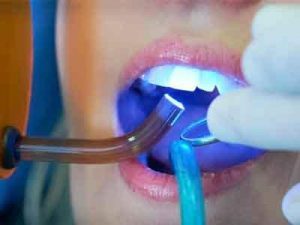- Home
- Editorial
- News
- Practice Guidelines
- Anesthesiology Guidelines
- Cancer Guidelines
- Cardiac Sciences Guidelines
- Critical Care Guidelines
- Dentistry Guidelines
- Dermatology Guidelines
- Diabetes and Endo Guidelines
- Diagnostics Guidelines
- ENT Guidelines
- Featured Practice Guidelines
- Gastroenterology Guidelines
- Geriatrics Guidelines
- Medicine Guidelines
- Nephrology Guidelines
- Neurosciences Guidelines
- Obs and Gynae Guidelines
- Ophthalmology Guidelines
- Orthopaedics Guidelines
- Paediatrics Guidelines
- Psychiatry Guidelines
- Pulmonology Guidelines
- Radiology Guidelines
- Surgery Guidelines
- Urology Guidelines
New Dental Material Resists Plaque and Kills Microbes

Dentists rely on composite materials to perform restorative procedures, such as filling cavities. Yet these materials, like tooth enamel, can be vulnerable to the growth of plaque, the sticky biofilm that leads to tooth decay.
In a new study, researchers from Penn Dental Medicine evaluated a new dental material tethered to an antimicrobial compound that can not only kill bacteria but can also resist biofilm growth. In addition, unlike some drug-infused materials, it is effective with minimal toxicity to the surrounding tissue, as it contains a low dose of the antimicrobial agent that kills only the bacteria that come in contact with it.
"Many products need large amounts of anti-microbial agents to maximize killing efficacy, which can weaken the mechanical properties and be toxic to tissues," said Geelsu Hwang, research assistant professor at Penn Dental Medicine, "but we showed that this material has outstanding mechanical properties and long-lasting antibiofilm activities without cytotoxicity."
Hwang collaborated on the study, which was published in the journal ACS Applied Materials and Interfaces, with Penn Dental Medicine professor Hyun (Michel) Koo and Bernard Koltisko and Xiaoming Jin of Dentsply Sirona.
The newly developed material is comprised of a resin embedded with the antibacterial agent imidazolium. Unlike some traditional biomaterials that slowly release a drug, this material is non-leachable, thereby only killing microbes that touch it.
"This can reduce the likelihood of antimicrobial resistance," Hwang said.
Hwang and colleagues tested the material's ability to kill microbes, to prevent the growth of biofilms, and to withstand mechanical stress.
Their results showed it to be effective in killing bacterial cells on contact, severely disrupting the ability of biofilms to grow on its surface. Only negligible amounts of biofilm matrix, the glue that holds clusters of bacteria together, were able to accumulate on the experimental material, in contrast to a control composite material, which showed a steady accumulation of sticky biofilm matrix over time.
Then, the team assessed how much shear force was required to remove the biofilm from the experimental material. "The force equivalent to taking a drink of water could easily remove the biofilm from this material," Hwang said, "while even a force four times as strong couldn't remove the biofilm from the control composite."

Disclaimer: This site is primarily intended for healthcare professionals. Any content/information on this website does not replace the advice of medical and/or health professionals and should not be construed as medical/diagnostic advice/endorsement or prescription. Use of this site is subject to our terms of use, privacy policy, advertisement policy. © 2020 Minerva Medical Treatment Pvt Ltd